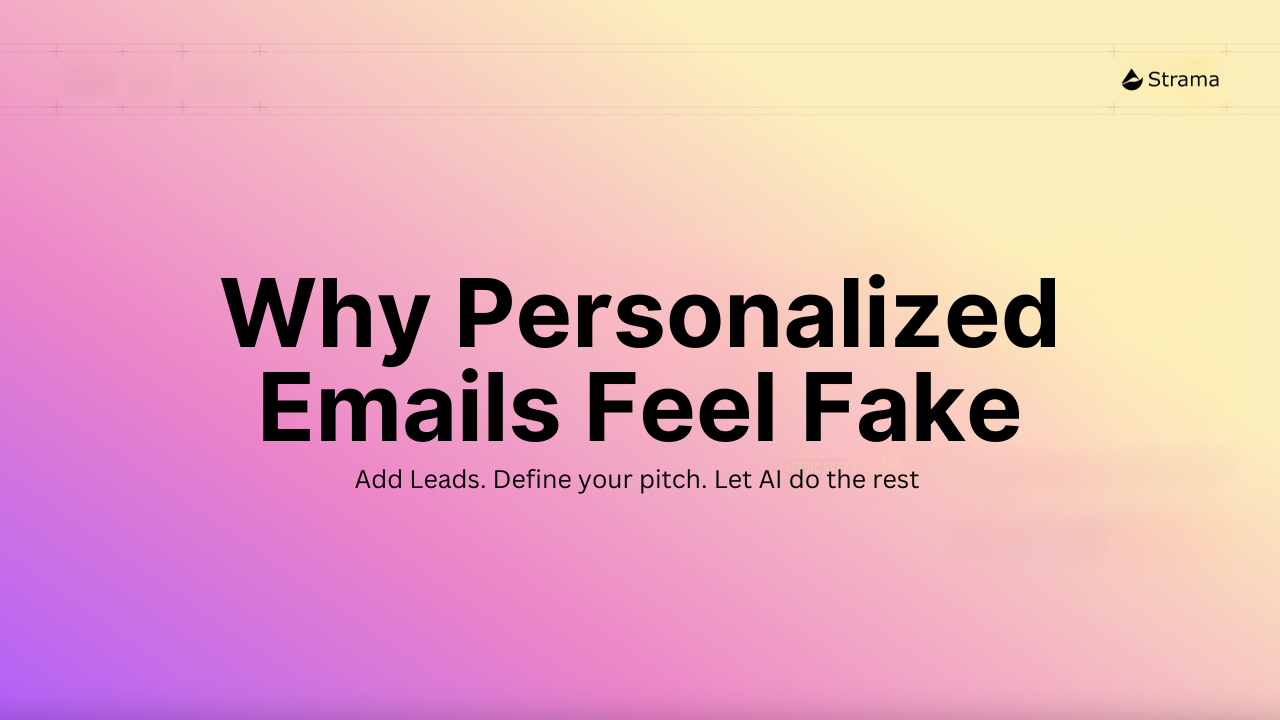Thursday, September 25, 2025
Breaking Free from Template Thinking


Your AI writes "personalized" emails mentioning the prospect's recent funding. So does every other seller who bought the same tool. The result? Your personalization looks exactly like everyone else's.
The Personalization Paradox
Here's what passes for personalized sales emails in 2025:
"Hi [First Name], I noticed [Company] just [recent event]. Companies like yours often struggle with [generic pain point]."
The variables are filled in. But it feels like a horoscope—specific enough to seem personal, generic enough to apply to anyone.
A recent conversation with an enterprise sales rep revealed the problem. He'd been sending hundreds of automated InMails daily with all the personalization features. But prospects could "sniff it out from a million miles away."
The numbers confirm his experience. With response rates averaging just 1-5% for cold outreach, the vast majority of these 'personalized' messages fail to generate any engagement.
Why Outreach, SalesLoft, and Apollo Can't Fix Personalization
Outreach, SalesLoft, Apollo—they're built on template architecture from a decade ago. They've bolted on AI, but the foundation is still templates with variables.
The newer AI players aren't better. They wait for triggers—website visits, funding rounds—then fire off smarter templates. When five companies email the same prospect about their Series B on the same day, the emails are virtually identical.
The Hidden Cost of Fake AI Personalization
One sales leader with 40 warmed email domains realized the infrastructure requirements of high-volume outreach had forced him into "spray and pray." He was "blasting out to everybody 1500 people at a time" when what worked required being a "spearfisher."
The math is brutal. With typical cold email response rates averaging just 1-5% according to industry benchmarks, you need hundreds of emails to generate meaningful conversations. Every fake-personalized miss degrades your brand.
Real Sales Email Personalization That Works
Real personalization isn't about mentioning facts—it's about demonstrating understanding.
Instead of "I saw your funding announcement," try "Your recent Southeast expansion probably means different compliance requirements than your California operations."
The difference? The first is a Google search. The second shows you understand implications.
Research proves this matters: personalized subject lines can increase open rates by 26-50%¹ according to multiple studies. But it's not about using their name—it's about relevance that demonstrates understanding.
Tailored Intelligence vs Generic Data Dumps
Daily updates create noise. Hourly triggers make you reactive. Tailored intelligence—specific to each prospect and aligned with your value proposition—captures what matters. Updated weekly to ensure relevance without noise:
- Strategic shifts, not stock fluctuations
- Priority changes affecting buying decisions
- Role transitions creating opportunities
McKinsey research² shows that companies using multi-channel outreach strategies achieve significantly better results, with one study finding that 72% of B2B companies that sell across seven or more channels grew their market share.
Breaking Free from Template Thinking
Research Beyond the Obvious
Skip LinkedIn and Crunchbase—everyone's there. Check job postings for priorities. Watch conference talks for philosophy. Read industry publications for challenges.
Write for Context, Not Category
A VP of Sales with two underperforming BDRs in Alabama faces different challenges than one scaling in San Francisco. Same title, different reality.
Test the Recipient's Perspective
Ask: "Could this email go to their competitor?" If yes, it's not personalized enough.
The Path Forward
The winners in 2025 won't have the fastest AI or most triggers. They'll understand that personalization isn't a feature—it's a philosophy.
Legacy providers will keep adding AI to their template foundations. Trigger-based tools will race to the same prospects. Meanwhile, companies doing tailored research specific to each prospect and value proposition will book meetings with prospects who reply, "This is one of the better cold outreaches I've received."
Because prospects don't want personalization. They want relevance. And relevance requires understanding, not just information. That understanding comes from research tailored to each prospect based on your unique value proposition—not generic data dumps.
Stop sending emails that get deleted in 2 seconds. See exactly how Strama writes outreach that actually works.
Watch our tutorials → Learn how to build personalized outreach campaigns that book meetings.
[Get a 2-minute demo →] See us turn a cold prospect into personalized outreach in real-time.
FAQ
Q: Why do personalized emails feel fake?
A: They use surface-level data everyone mentions rather than demonstrating understanding of specific challenges.
Q: What's the difference between personalization and relevance?
A: Personalization mentions facts. Relevance understands what those facts mean for their business.
Q: How often should sales intelligence update?
A: Weekly captures meaningful changes without noise. Daily is too much, monthly misses opportunities.
Q: What makes AI outreach detectable?
A: Patterns like "I noticed," "companies like yours," and generic pain points. Prospects recognize these instantly.
Q: How can I test if my personalization is working?
A: Ask yourself: "Could this exact email be sent to my prospect's competitor?" If yes, it's not personalized enough. True personalization should be specific to that person's unique situation.
Q: How is Strama different from Apollo, Outreach, or SalesLoft?
A: While those platforms use templates with variables, Strama provides tailored research specific to each prospect and your unique value proposition. We don't just pull data—we understand implications and context.
---
References
1. Campaign Monitor. "The Email Marketer's Guide to Subject Lines." Accessed 2025. https://www.campaignmonitor.com/resources/guides/the-email-marketers-guide-to-subject-lines/
2. McKinsey & Company. "B2B Pulse: Three Key Trends in B2B Marketing and Sales." 2024. https://www.mckinsey.com/industries/growth-marketing-and-sales/our-insights/b2b-pulse-three-key-trends-in-b2b-marketing-and-sales